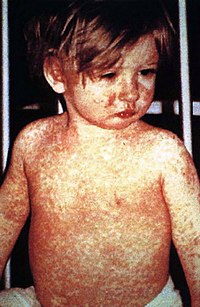
Photo from wikipedia
A 73-year-old male who complained a typical effort angina underwent percutaneous coronary intervention for severe stenosis with eccentric calcified plaque in the mid-left anterior descending (LAD) artery (Fig. 1a). Optical… Click to show full abstract
A 73-year-old male who complained a typical effort angina underwent percutaneous coronary intervention for severe stenosis with eccentric calcified plaque in the mid-left anterior descending (LAD) artery (Fig. 1a). Optical coherence tomography (OCT) after pre-dilatation with a 2.5 mm semicompliant balloon catheter showed distribution of calcified nodule around the lesion. Balloon inflation caused coronary dissection (Fig. 1b), which spread behind the calcified nodule, and the guidewire slipped into the cleft in the distal segment of the lesion (Fig. 1c). On the other hand, no major modification in the calcified nodule was induced around the proximal segment of the lesion (Fig. 1d). We added balloon dilatation with a 2.5 mm scoring balloon catheter (NSE PTA; GOODMAN Co., Ltd., Aichi, Japan) at rated burst pressure several times for further modification in the proximal segment of the lesion. Next, when we implanted a drug-eluting stent, coronary perforation occurred at the distal segment of the lesion with coronary dissection (Fig. 1e). OCT showed moderate expansion of the dissected lumen at the point of perforation (Fig. 1f), contrary to less expansion of the stent around the proximal segment of the lesion (Fig. 1g). Coronary perforation was successfully treated with a long-time inflation of a perfusion balloon catheter (Fig. 1h). Ordinary dual antiplatelet therapy was prescribed and he has been uneventful after this procedure. It is considered that calcified sheets or plates break and form calcified nodules that protrude into the lumen with platelet-rich thrombi. This can cause acute coronary syndrome [1, 2]. Lesions with calcified nodules are more commonly highly calcified, tortuous arteries in older males, and are most frequently found in the middle right coronary or LAD arteries [1]. When stents are implanted in such a specific lesion, more attention is needed for lesion modification. As a calcified nodule is commonly generated through the process of disruption of calcified sheets, there are some opinions that such lesions are not difficult to expand by balloon inflation. However, there is no evidence to establish optimal lesion modification for a calcified nodule. Our case is very instructive with regard to the treatment for calcified nodules, not only to achieve adequate stent expansion but also to prevent severe vascular injury. To achieve a sufficient vascular expansion without malignant dissection before stenting in such a calcified lesion, debulking devices such as rotational atherectomy [3] or excimer laser coronary atherectomy [4] would be effective. Moreover, we should have rerouted another guidewire into the luminal space using duallumen micro-catheter to avoid coronary perforation at the dissected lesion.
Journal Title: Cardiovascular Intervention and Therapeutics
Year Published: 2018
Link to full text (if available)
Share on Social Media: Sign Up to like & get
recommendations!